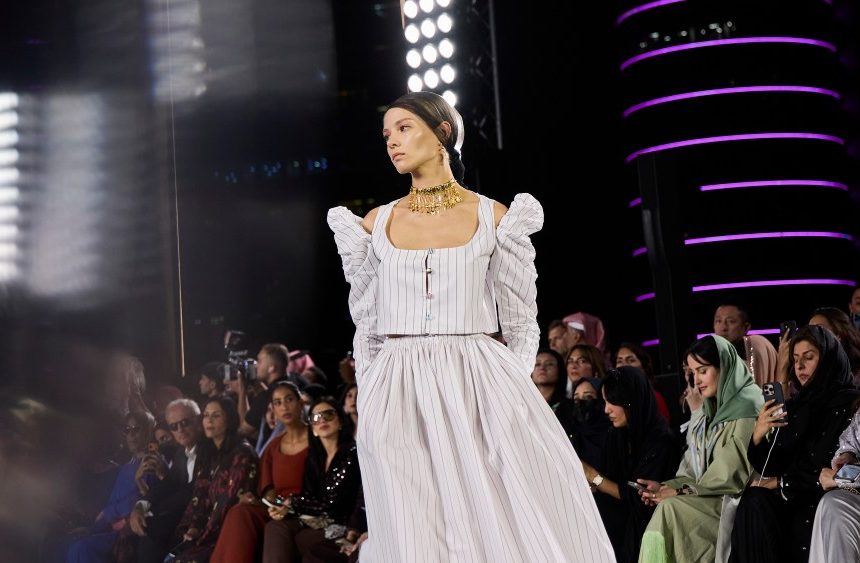Fashion thrives on creative tension, and in particular on the pull exerted by the opposing forces of maximalism and minimalism. We’re still in a maximalist era, but that makes minimalism even more important — which helps to explain much of the adulation greeting Matthieu Blazy’s debut collection for Chanel during Paris fashion week in October.
As Dionysian exuberance in full swing at houses such as Yves Saint Laurent, Blazy’s Apollonian conceptualism stood out. The designer has spent his whole career working inside the high temples of structure and austerity—Raf Simons, Maison Margiela, Phoebe Philo’s Céline, Calvin Klein. Most recently he was at Bottega Veneta, where he was described as the antithesis of the theory that fashion should be a spectacle. Now, at Chanel, he’s teamed up with the equally venerable Parisian house of Charvet to make shirts tailored meticulously to be worn untucked, with Chanel’s trademark chain sewn invisibly into the hem to maintain the perfect weight and silhouette.
Blazy’s coming-out party took place the night before the official opening of “Minimal”, the blockbuster survey show of minimal art that’s showing at the Pinault Collection in central Paris through Jan. 19. Most of the show is drawn from the enormous personal collection of Francois Pinault, the billionaire who founded what has become luxury giant Kering SA, which owns fashion houses including Bottega Veneta.
Kering’s most consequential move this season was entirely maximalist: Georgian designer Demna, whose distorted, grotesque concepts at Balenciaga went viral on social media and in luxury showrooms, was named creative director of Gucci, the company’s most important brand. The hope is that Demna, who managed to increase Balenciaga’s revenue more than fivefold during his decade as creative director, will be able to work similar magic at Gucci, where sales plunged 25 percent in the second quarter from the same period last year.
Yet a glance at architect Tadao Ando’s stunningly stripped-down renovation of the Bourse de Commerce, which houses the Pinault Collection, suffices to show where Pinault’s sympathies ultimately lie. Indeed, the exhibition guide for the most recent show opens with a quote from Pinault calling minimal art “the driving force that has accompanied and inspired me for over 50 years.” It’s a far cry from the exuberant maximalism of rival Bernard Arnault’s museum, the Fondation Louis Vuitton, where the easy and colourful David Hockney summer blockbuster has given way to an equally enormous, and arguably even more colorful, Gerhard Richter retrospective, showing through March 2.
In the case of Pinault, it’s not hard to see why a fashion executive would develop an obsession with minimal art — and design. The “less is more” ethos of the mid-1920s produced not only Coco Chanel’s little black dress but also Marcel Breuer’s equally timeless “Wassily” tubular-steel chair. To that, the minimal artists of the 1960s added an extra ingredient: an emphasis on the physical, bodily feeling of interacting with a work.
Minimalism was the point at which art stopped being mainly visual — stopped being a painting on a wall or a sculpture on a plinth — and instead became centred on the encounter of a human viewer with a resolutely physical object. Minimal art is at its heart theatrical: “The work of art is to be experienced by the body,” writes art historian and curator Emma Lavigne in her lead essay for the “Minimal” exhibition catalog. “It must be inhabited and traversed.”
The feeling that your own body has become an integral part of an important artwork is exactly where minimal art overlaps with fashion. An exquisitely structured piece by Helmut Lang or Rei Kawakubo of Comme des Garçons is almost nothing before it’s worn: The wearer is the final piece of the puzzle that brings everything together. Much the same can be said about masterpieces of minimal art: Carl Andre’s floor pieces and Donald Judd’s cubes are inert until they’re activated by the moving, feeling presence of the viewer.
The befuddlement that famously greeted the Tate Gallery’s acquisition of Andre’s “Equivalent VIII” in 1972 — it was derided as nothing more than a “pile of bricks” — echoed the way Japanese designers of the 1980s, including not only Kawakubo but also Yohji Yamamoto and Issey Miyake, were initially received. “A lot of people didn’t understand them,” says Melissa Marra-Alvarez, the curator of “Minimalism/Maximalism”, a 2019 exhibition at New York’s Fashion Institute of Technology. “They didn’t glorify the body in an ostentatious way. They were about a woman’s relationship with her clothing and her body.”
Fashion gives the world a reprieve from quotidian life. That’s perhaps why periods of growth and optimism, including the 1920s and 1960s, have tended to coincide with an upswing of minimalism. Conversely, the heyday of maximalist couture, as exemplified by a flower-studded evening gown Hardy Amies designed in 1948, came in the wake of the horrors of World War II.

Daily life now pairs existential dread with inflation-driven austerity, which may help explain why Kering has elevated Demna to helm its flagship brand and encouraged him to commission a star-studded, hallucinogenic Spike Jonze short film. All the same, the company clearly understands the importance of structure and rigour. At Balenciaga, where sales growth may have finally come to an end, Demna has been replaced by Pierpaolo Piccioli, the former creative director of Valentino, who has a framed quotation in his office saying “simplicity is the ultimate sophistication.” The decision to place a true couturier in charge of the house is a sign that Kering doesn’t want to rely entirely on hypebeasts.
Minimalism is similar to, but not exactly the same as, the “stealth wealth” simplicity exemplified by Loro Piana or the Row, where the emphasis is more on comfort and timelessness than on making an artistic statement. All the same, the esteem in which those brands are held is a sign of just how commercial high-end, stripped-down fashion can be. Loro Piana has been reported to be the third-largest brand in the LVMH fashion and leather goods portfolio, with revenue estimated at almost $3 billion per year.
The quietness of minimalism means it will never have the buzz of flashier art. Blazy will probably never be as famous as Demna, and the Pinault Collection’s “Minimal” show will undoubtedly be overshadowed by the Foundation Louis Vuitton’s Richter retrospective.

For a plutocrat, a large Richter in your living room is an instantly recognisable status symbol, one with maximal “wall power” to boot. For many buyers, it’s a way of showing off. A work like Nobuo Sekine’s “Phase of Nothingness–Water,” by contrast, on show at the Bourse de Commerce, is more soulful. An initial glance reveals very little: It requires the participation of the viewer, who needs to walk around it, to think about it, to put effort into it. That’s reflected in the market: Sekine’s auction record is $350,000; Richter’s is $46 million. Alternatively, take a look at Artnet’s list of the “most bankable” postwar and contemporary artists: You’ll find Warhol and Basquiat leading their respective league tables, and nary a minimalist in sight.
Spectacle is fun; simplicity is boring in comparison. But boredom is perhaps the thing contemporary society is most sorely lacking. In a world of noise and hype and ever-shortening attention spans, minimalist art and fashion provide not only a foundation of rigor and conceptual strength but also an opportunity to become more mindful of how we move through space and time.
By Felix Salmon


